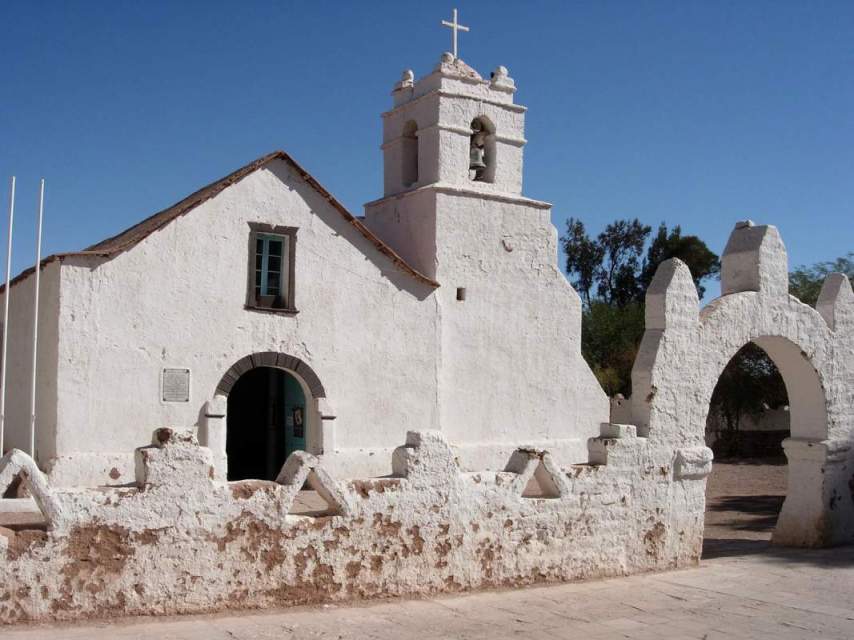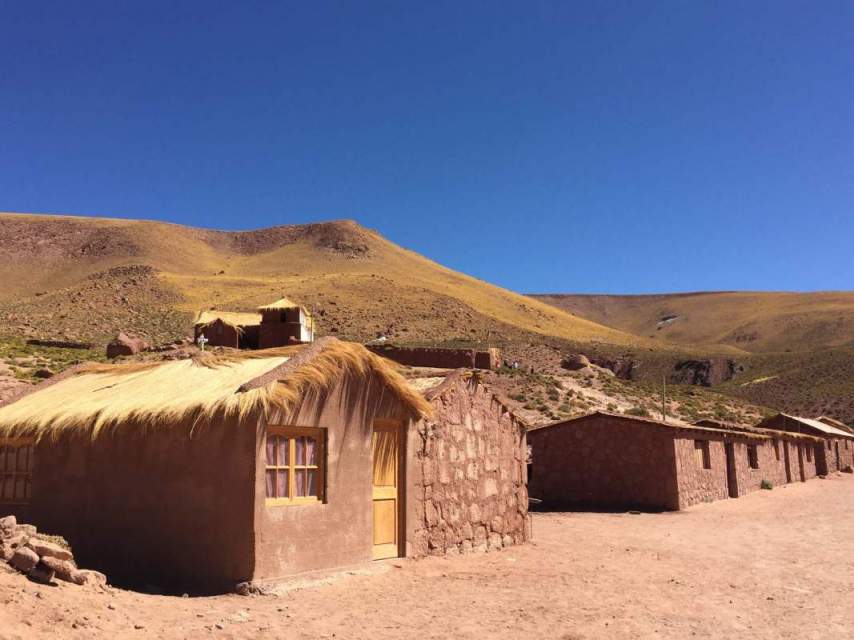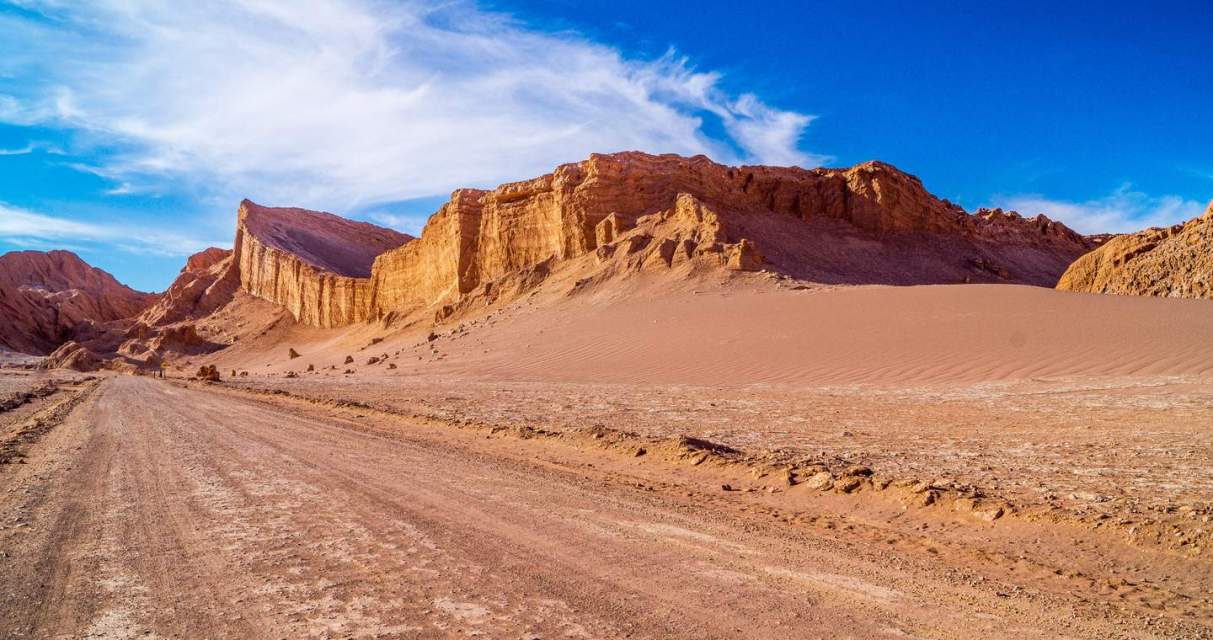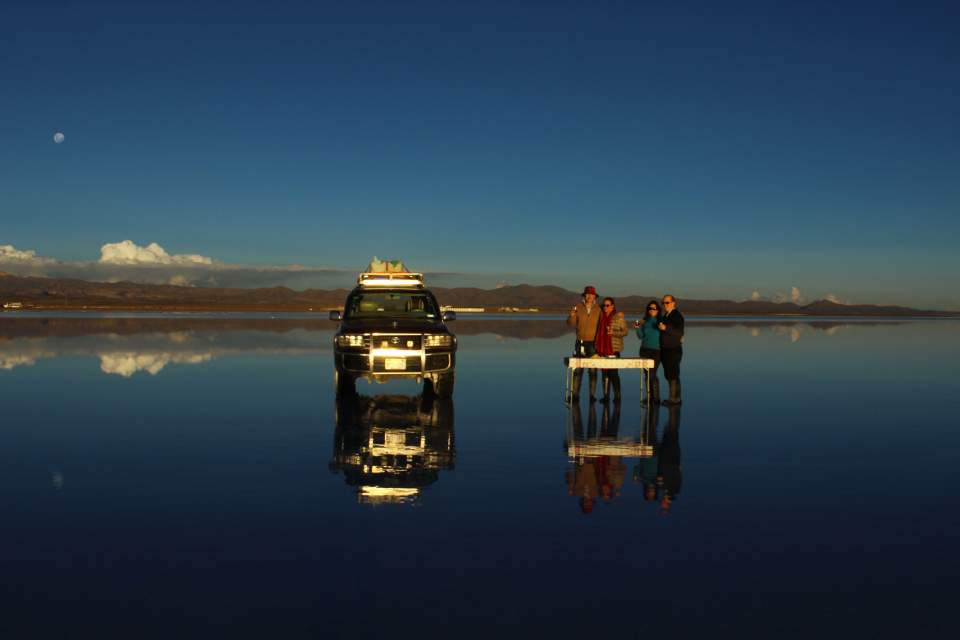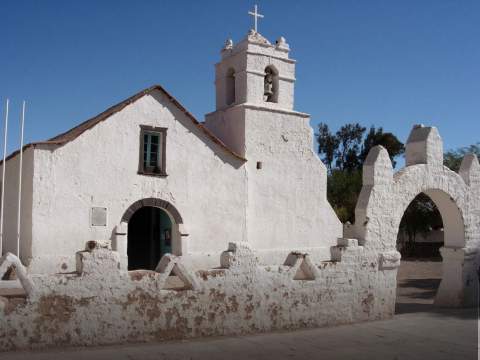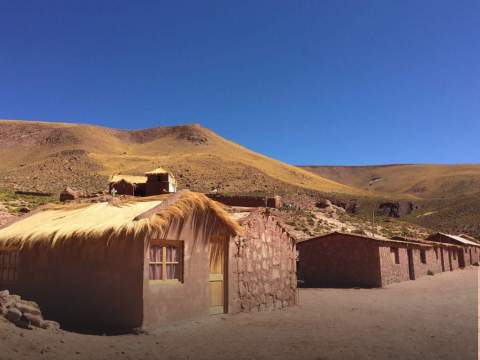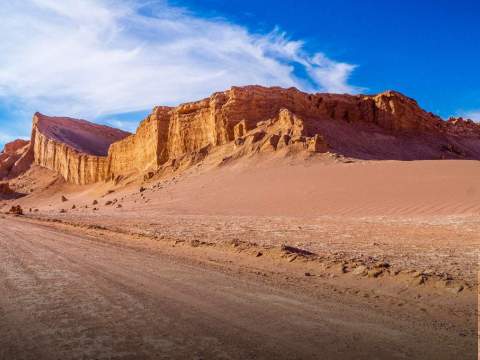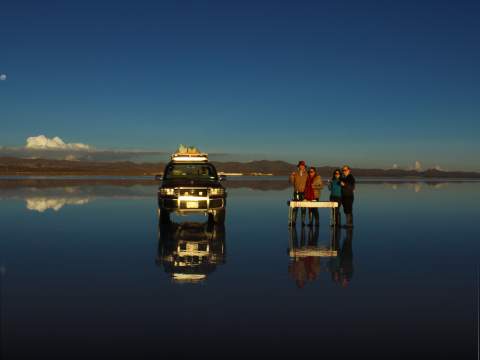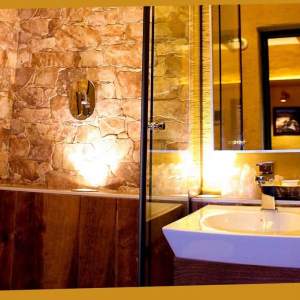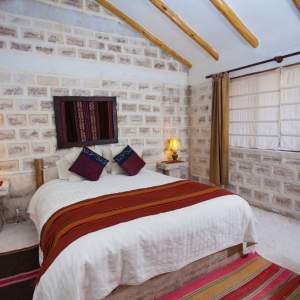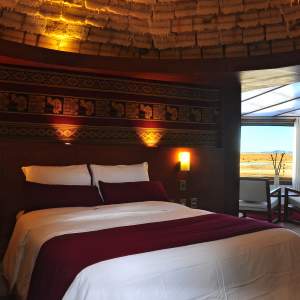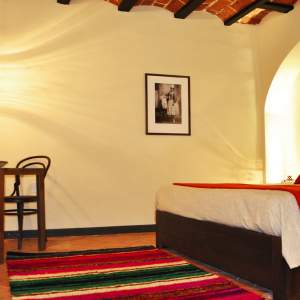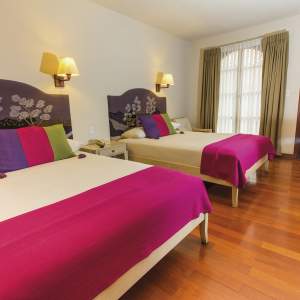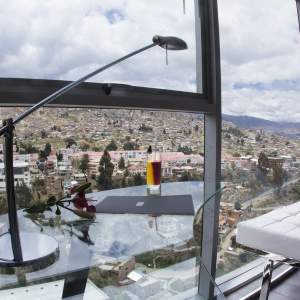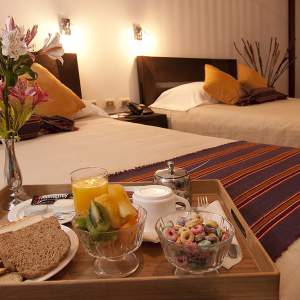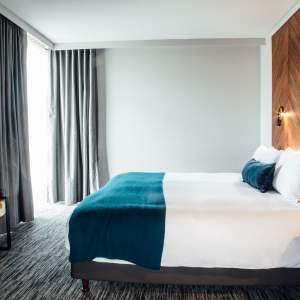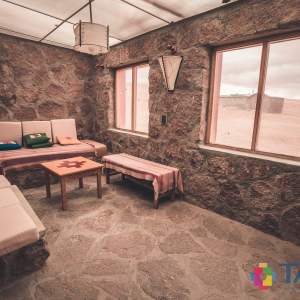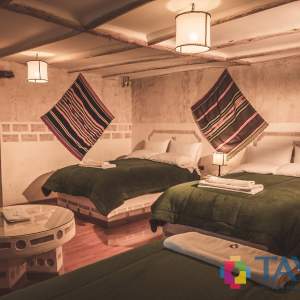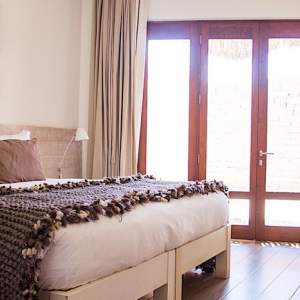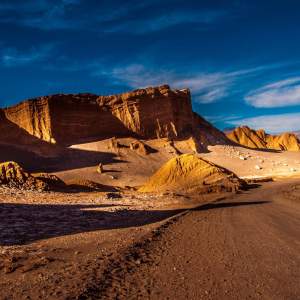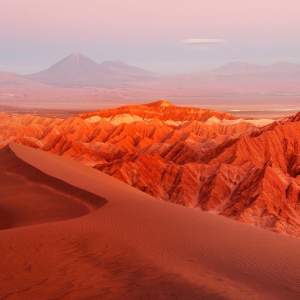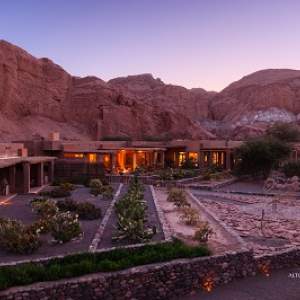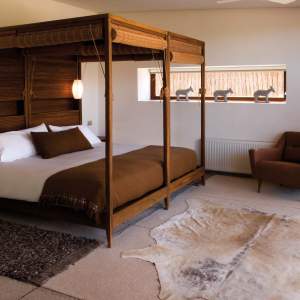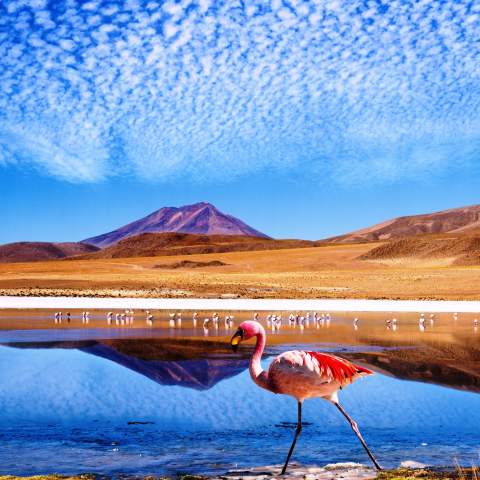Atacama Desert & Bolivian Salt Flats
Experience some of South America’s dramatic terrain in two different countries on this nine-day private tour. Travel to expansive salt flats, steaming geysers, scenic lagoons and high elevation desert on both sides of the border. After full days exploring with your guide in your four-wheel drive vehicle, spend the evenings relaxing in cozy locally-owned accommodations and enjoying the stunning panorama of southern constellations that can be seen so clearly here.Most Popular Chile Trips & Tours
| Trip | Price | Days | Highlights |
|---|---|---|---|
| Australis Glacier Cruise & Patagonia Hiking | $6,560 | 12 Days | Mt. Fitz Roy & Cerro Torre, Cape Horn, Tierra del Fuego National Park, Los Glaciares National Park, Perito Moreno Glacier |
| Chile Triangle | $6,845 | 12 Days | Chile's most famous regions, Easter Island, a UNESCO World Heritage Site , Atacama Desert, Torres del Paine National Park |
| Classic Patagonia & Torres del Paine | $6,425 | 10 Days | Los Glaciares National Park, Torres del Paine National Park, Perito Moreno Glacier, Classic Treks to Mt. Torre and to Mt. Fitz Roy |
| Lake District and Chiloe Island | $2,995 | 7 Days | Myths and legends in Chiloe Island, Lake District, Llanquihue Lake and majestic Osorno Volcano |
- DAY 1: CALAMA – SAN PEDRO DE ATACAMA – VALLE DE LA LUNA
- Upon arrival at the Calama airport, you will be met by your driver for the sixty-minute ride to your selected accommodation in San Pedro de Atacama. The town stands as an oasis in the midst of the world’s driest desert, where geological evidence suggests that certain areas have never experienced rainfall. Here a rich pre-Colombian cultural history dating back thousands of years lives on today in traditional artisan crafts and a renowned archaeological museum. Enjoy the morning getting settled and exploring on your own.
In the afternoon, you will travel to Valle de la Luna (Valley of the Moon), aptly named for its lunar-like landscape. Unique rock and salt formations carved over millions of years by floods and wind appear sculpted by man. You’ll watch the mesmerizing colors of the mountains change in a colorful sunset over the Cordillera de la Sal from your perch atop sand dunes. You will be returned to your hotel for a free evening.
- DAY 2: LAGUNA CEJAR
- Today you have the morning free and travel to Laguna Cejar after lunch. Located just twelve miles from San Pedro, the lagoon is an ideal spot for relaxation. It sits in the middle of the Atacama salt flat, surrounded by salt crystals. Due to the large concentration of salt, you float effortlessly in Cejar Lagoon’s waters. Nearby, you can also take a dip in the Ojos del Salar (Eyes of the Salt Flat), two smaller freshwater pools. After enjoying these refreshing sights, you will enjoy a delicious appetizer while witnessing a spectacular sunset over the Tebinquinche Lagoon before being returned to your hotel for another evening on your own. (B)
- DAY 3: SALAR DE ATACAMA & TOCONAO
- After breakfast, today’s visit to the famed Salar de Atacama (Salt Lake) begins. The first stop is the National Flamingo Reserve, entered through the Chaxa Lagoon. The sight is formed by a gigantic depression of more than 2,100 square miles. The Salar de Atacama is the largest salt field in Chile. Its large quantity of salt makes the vast surface white and rough, offering panoramic views of the area. The bottom of the salt field is composed of an enormous lake, which receives water from rivers and melting snow. As it has no runoff, several small lagoons have formed, where the three types of flamingos inhabiting the area, the James, the Andean and the Chilean, may be observed.
On the way back you pass through Toconao, a village of 600 inhabitants who make their living through agriculture and artisan handicrafts of local materials (llama and alpaca wool, cactus wood, volcanic rock). Here you will also see the Tower of Saint Lucas, a national monument and symbol of Toconao, as well as houses constructed of pumice extracted from the nearby quarry. On returning to your hotel, you have the rest of the day to yourself. (B)
- DAY 4: TATIO GEYSERS
- Thousands of stars and the mighty brushstroke of the Milky Way will still be visible at this morning’s 4 AM departure to experience sunrise at the Tatio Geyser Field, 14,000 feet above sea level. The early start gives visitors the most photogenic view of El Tatio, the third largest geyser field in the world. The eruptions of steaming water are produced by the convergence of groundwater above a lava field which causes huge plumes of steam and gas to expel through the cracks, sometimes exceeding 32 feet. Afterward, you may enjoy a rejuvenating soak in the thermal hot springs where temperatures reach 85 degrees Fahrenheit.
On the way back, the majestic Andean peaks seem close enough to touch. You’ll stop briefly at Machuca, a small llama herder settlement. This picturesque village is filled with thatched roof adobe houses and green wetlands. In the afternoon, you’ll return to your hotel for one final night in Chile. (B)
- DAY 5: SAN PEDRO DE ATACAMA – HITO CAJON BORDER CROSSING – BOLIVIA – SILOLI DESERT
- Your driver meets you at the hotel after breakfast for the one hour drive to Bolivia’s border crossing at Hito Cajon. Here you will be assisted with the border crossing and met by your new guide on the Bolivian side. Continue on to Laguna Blanca and Laguna Verde, at the base of the Licancabur Volcano. Our tour continues to the Salvador Dali Rocks, here wind and water erosions have shaped the rocks into absurd forms in the middle of the Altiplano desert. Your exploration of the Eduardo Avaroa Reserve continues with where you’ll see to the Sol de Mañana geysers and a pool of natural hot springs with safe bathing temperatures, where we are welcome to soak for a while. You’ll also see the spectacular Laguna Colorada where it is possible to observe thousands of flamingos and the Arbol de Piedra, the eroded rock in the shape of a tree. Lunch will be enjoyed en route. This evening, spend the night in the Siloli Desert. (B,L,D)
- DAY 6: SILOLI DESERT – SALT FLATS
- After breakfast, you set out to visit several lagoons: Cañapa, Hedionda, Chiarcota, Honda, and Ramaditas which offer views of 3 different flamingo species: the James, the Andean and the Chilean, as well as wild troops of Vicuna. Head to Paso de León, a spectacular viewpoint to observe the Ollague Volcano, which is currently mildly active. Enjoy scenic stops along the way to our final destination in the village of Tahua, at the base of the Tunupa Volcano. Here you have a unique location for an amazing sunset that colors up the landscape of the salt lake. Overnight in the village of Tahua. (B,L,D)
*It is possible to arrange additional touring of the Salt Flats under the stars in the evening. This should be arranged directly with your guide and driver on the day in order to take into account weather conditions. Please contact us for more details.
- DAY 7: SALT FLATS – COLCHANI
- After breakfast, you head back out on the salt flats and drive towards Isla Incahuasi. Here you can hike among huge cacti and experience the world renowned 360 degree views of the endless Uyuni Salt Lake. After our stop at the island, we will continue past the first hotel that was made entirely of salt blocks, which has now been converted into a small museum. This is a great place for us to stop for lunch and to take one of those famous perspective photos. After lunch we continue to the village of Colchani where locals extract and process salt. Here you’ll learn the interesting aspects of the geological history of the Uyuni´s Salt Lake and the current natural processes of salt formation that has continued for thousands of years. Spend your last night in this region in the region of Colchani. (B,L,D)
- DAY 8: UYUNI - LA PAZ TOUR
- This morning you are picked up at your hotel and transferred to the airport for a one-hour flight back to La Paz. Upon arrival, we’ll immediately begin exploring the city. Explore picturesque and traditional sites, such as Jaen Street, the Museum of Precious Metals, San Francisco Church, the witches market, and Plaza Murillo lined with prominent buildings including the Presidential Palace, the National Congress and La Paz Cathedral. The tour continues towards the bohemian neighborhood called Sopocachi, home to the gondola system called MI Teleférico. You will enjoy incredible views of the city from the Teleferico. The day wraps up with a visit to the Valley of the Moon, which isn’t actually a valley at all. Here you’ll see a eroded maze of canyons and pinnacles that gives this place its name. (B,L)
- DAY 9: LA PAZ - HOME
- Your guide will meet you and transfer you to the airport for your international flight home, marking the end of Southern Explorations services. (B)
Weather (Chile)
When to Visit- jan
- feb
- mar
- apr
- may
- jun
- jul
- aug
- sep
- oct
- nov
- dec
Santiago & Surrounding Vineyards - The fertile heartland, this midland area of Chile enjoys a Mediterranean climate, with maximum temperatures averaging 82°F (28°C) in January and 50°F (10°C) in July. The rainy season lasts from May to August. Evenings and nights can be cool, even during the summer.
General Patagonia - The area south of Puerto Montt and Chiloé covers about 30% of the total land area of Chile. It is a rugged, mountainous region of tremendous beauty. Westerly winds and storms often drop enormous amounts of snow and rain on the seaward slopes. In the Magellanes and Tierra del Fuego areas, temperatures in summer average 52°F (11°C). Dampness and wind chill can make it feel cooler so layered clothing and good waterproof gear are musts. The weather year-round is highly unpredictable, and in summer be prepared for incessant winds that lessen in the winter. In the shoulder season months, November and March, winds are not likely to be as strong as during the peak of summer.
Torres Del Paine - The weather is famously unpredictable in this area and it is possible to experience four seasons in the course of a few hours. Average daily temperatures vary but in summer one can expect temperatures ranging between 50° F (10° C) and 70° F (20 ° C) with the occasional hot day of 78° F (25° C). Temperatures can drop to zero at night, and high winds are common in this area. Travelers should be prepared (both mentally and physically) for unpredictable and sometimes challenging weather conditions and pack accordingly. Good head-to-toe, breathable waterproof clothing is essential.
SANTIAGO | Min-Max Air Temp | Avg Rainfall |
| JAN | 54-85 | 0.0 |
| FEB | 54-84 | 0.1 |
| MAR | 52-80 | 0.2 |
| APR | 47-72 | 0.5 |
| MAY | 40-64 | 2.3 |
| JUN | 40-58 | 3.1 |
| JUL | 37-57 | 3.0 |
| AUG | 38-61 | 2.1 |
| SEP | 40-65 | 1.1 |
| OCT | 45-71 | 0.5 |
| NOV | 47-77 | 0.2 |
| DEC | 51-82 | 0.2 |
*Year Round Temperatures in °F, Rainfall in Inches
PUERTO MONTT | Min-Max Air Temp | Avg Rainfall |
| JAN | 48-66 | 3.6 |
| FEB | 47-67 | 3.7 |
| MAR | 47-64 | 3.9 |
| APR | 43-60 | 5.6 |
| MAY | 42-56 | 9.2 |
| JUN | 39-51 | 8.8 |
| JUL | 37-50 | 9.0 |
| AUG | 38-52 | 8.2 |
| SEP | 38-52 | 5.7 |
| OCT | 38-52 | 4.8 |
| NOV | 43-60 | 0.5 |
| DEC | 46-63 | 4.1 |
*Year Round Temperatures in °F, Rainfall in Inches
PUNTA ARENAS | Min-Max Air Temp | Avg Rainfall |
| JAN | 43-57 | 1.4 |
| FEB | 44-57 | 1.1 |
| MAR | 51-54 | 1.6 |
| APR | 39-49 | 1.6 |
| MAY | 35-44 | 1.7 |
| JUN | 31-39 | 1.3 |
| JUL | 29-38 | 1.3 |
| AUG | 31-41 | 1.3 |
| SEP | 32-46 | 1.1 |
| OCT | 36-50 | 0.9 |
| NOV | 40-53 | 1.1 |
| DEC | 42-56 | 1.2 |
*Year Round Temperatures in °F, Rainfall in Inches
SAN PEDRO ATACAMA | Min-Max Air Temp | Avg Rainfall |
| JAN | 50-76 | 0.9 |
| FEB | 50-75 | 0.2 |
| MAR | 48-73 | 0.1 |
| APR | 44-70 | 0.1 |
| MAY | 38-66 | 0.0 |
| JUN | 33-61 | 0.0 |
| JUL | 33-61 | 0.0 |
| AUG | 35-64 | 0.0 |
| SEP | 40-69 | 0.1 |
| OCT | 43-72 | 0.1 |
| NOV | 46-74 | 0.1 |
| DEC | 48-75 | 0.1 |
*Year Round Temperatures in °F, Rainfall in Inches
EASTER ISLAND | Min-Max Air Temp | Avg Rainfall |
| JAN | 68-81 | 2.8 |
| FEB | 68-81 | 3.3 |
| MAR | 68-80 | 3.8 |
| APR | 66-77 | 4.8 |
| MAY | 64-74 | 6.0 |
| JUN | 62-72 | 4.2 |
| JUL | 60-70 | 4.1 |
| AUG | 60-70 | 3.7 |
| SEP | 60-71 | 3.4 |
| OCT | 61-73 | 2.7 |
| NOV | 63-75 | 2.9 |
| DEC | 65-78 | 3.4 |
*Year Round Temperatures in °F, Rainfall in Inches
Maps
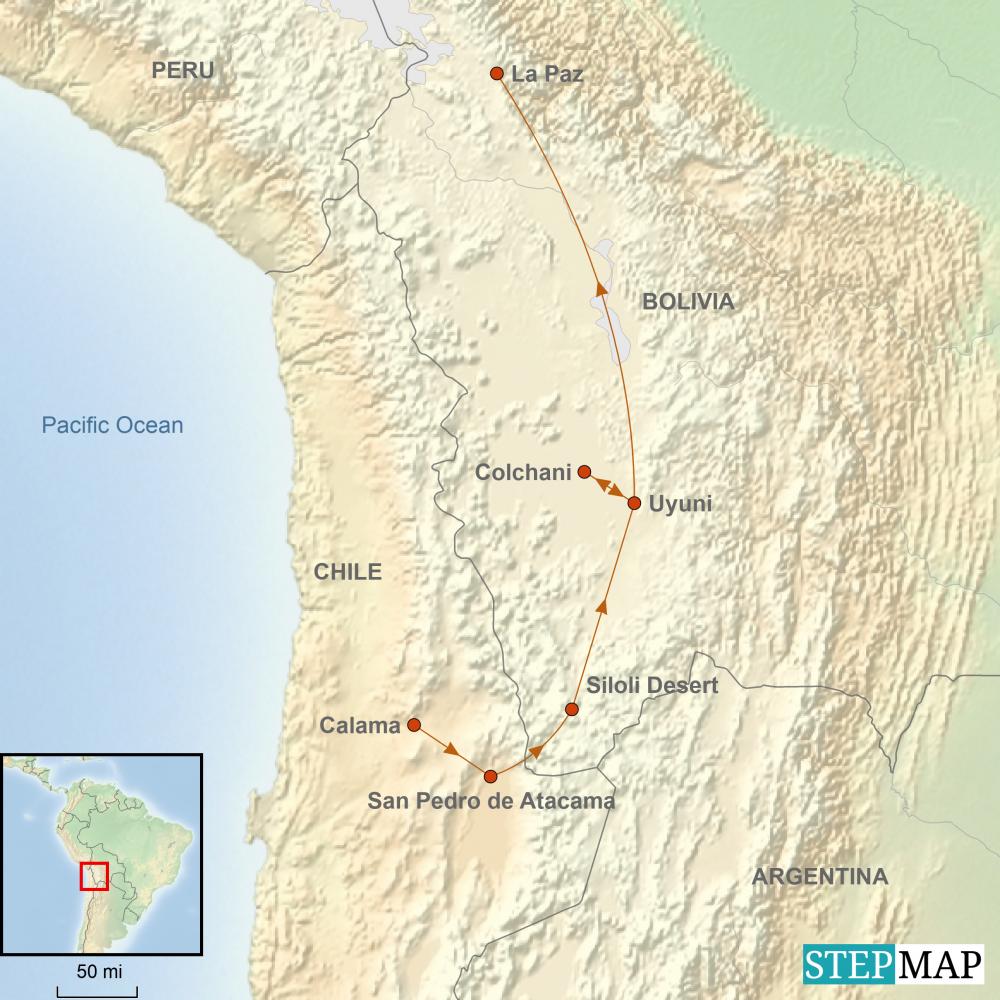
Atacama Desert & Bolivian Salt Flats
- Pricing
- 2-3 Travelers$5,995Domestic Airfare:Uyuni/La Paz - $185
BOLIVIAN VISA: All US Citizens are required to have a Tourist Visa to enter Bolivia. The cost is $160. This visa can be obtained in advance or at the border crossing. A visa is not required for Canadian, Australian, New Zealand and most European citizens if visiting for less than 90 days. Visas are required for citizens of some Asian and African countries and for those coming from countries with risk of Yellow Fever. - Included in tour cost
- All airport/hotel transfers
- All hotel accommodations
- All listed activities
- English-speaking certified guides
- Entrance fees for all scheduled tours, national parks & archaeological sites
- Meals as indicated
- Southern Explorations pre-departure services
- Excluded from tour cost
- Airport taxes, international and local
- Domestic airfare within South America
- International airfare to and from Central & South America
- Tips and gratuities
- Medical & travel insurance (highly recommended)
- Hiking boots and other necessary sports gear
- Optional activities
- Visa fee
Atacama Desert & Bolivian Salt Flats
- Trip Dates
- Southern Explorations can arrange a private departure on any date that works with your schedule. Custom tours are also available. Contact us for details.Available
- Colchani
- Hotel upgrades are available, please contact us to discuss your options.
-
3 Star
-
3 Star
-
4 Star
-
4 Star
-
- La Paz
- Hotel upgrades are available, please contact us to discuss your options.
-
3 Star
-
3 Star
-
4 Star
-
4 Star
Included Hotel (subject to availability) -
5 Star
-
- Siloli Desert
- Hotel upgrades are available, please contact us to discuss your options.
-
3 Star
Included Hotel (subject to availability)
-
- Tahua
- Hotel upgrades are available, please contact us to discuss your options.
-
3 Star
Included Hotel (subject to availability)
-
- San Pedro de Atacama
- Hotel upgrades are available, please contact us to discuss your options.
-
4 Star
-
4 Star
Included Hotel (subject to availability) -
5 Star
-
5 Star
-
5 Star
-
5 Star
-
One Day
-
1 Day $115Witch's Market
Teleferico
Valley of the Moon
Old TownOne Day
- Bolivia - Frequently Asked Questions
- Q: How do I choose an itinerary?A: We offer both active and cultural tours that visit different regions including the Salt Flats, the Amazon, Lake Titicaca, La Paz and the Andes. These tours vary in length and level of accommodation. Our Adventure Travel Coordinators would be happy to chat with you to help you find the itinerary that best meets your needs and interests.Q: Do I need a visa to enter Bolivia?A:
As of December 15, 2019 US Citizens, Canadian, Australian, New Zealand and most European citizens don’t need a visa to enter Bolivia. Please check with your country's state department or international travel serivce for the most up to date information.
Q: When is the best time to go to Bolivia?A: Most areas in Bolivia are truly year-round destinations, but your itinerary may vary based on whether you travel in the dry season (May – December) or the rainy season (January – April). Our itineraries posted online are for the dry season, but we are happy to send you details on the rainy season alternatives as well. This can be particularly nice for photographers as the reflections off the salt flats are incredible. If you are totally flexible, September – November can be especially nice months because the temperatures are warmer than in the height of the winter in June and July. Please check with your Adventure Travel Coordinator for more details.Q: What is a typical day like on an Bolivia trip?A: A typical day in Bolivia will vary from tour to tour, but generally, you can expect your guide to pick you up to start your excursions right after breakfast with a full day of scheduled activities or sightseeing. A lunch break is included and you’ll retire to your hotel in the late afternoon with evenings free.Q: How physically fit do I need to be to enjoy a trip to Bolivia?A: Our Bolivia trips vary in level of activity, so the requirements differ based on itinerary. Please check our physical ratings for each itinerary to see what may be required of you when assessing your ability to enjoy a trip. All of our trips in Bolivia are at a minimum moderate physical rating due to the altitude. All of our standard tours include destinations of at least 12,000 feet above sea level. If you have any specific questions, please contact your Adventure Travel Coordinator. We have personal experience with these trips and can help you decide whether a trip is right for you.Q: How much time do I need to visit Bolivia?A: Most of our Bolivia itineraries are at least eight days in length, but we can potentially create shorter custom itineraries if needed.Q: How far in advance should I book?A: For the best guide availability and selection in hotels, we recommend booking three to six months in advance. Holidays and the summer months book up more quickly, so more advance planning is ideal. For the holiday season, we recommend booking at least eight months in advance.Q: What are your booking and cancellation policies?A: Click here to see our booking and cancellation policies.Q: Do you use certified guides?A: Our guides have been carefully selected for their knowledge, professionalism, experience and ability to effectively manage groups with finesse. We only hire guides who are native to the destination and are licensed or certified in accordance with the government regulations of their country. All are fluent in Spanish and English. Most have advanced degrees in tourism, biology, native culture or other related field. All guides are experienced in the outdoors and trained in basic first aid.Q: What kind of accommodations can I expect?A: In major cities we offer a variety of hotels ranging from historic boutique properties to modern, design-centered hotels. Throughout the rest of Bolivia we work with a combination of community-run lodges and boutique hotels. The majority of the properties are family-run or locally owned. All of our accommodations are clean and comfortable, with private bathrooms and hot water. We offer basic or luxury options in many locations, depending on taste and budget, but some locations have more rustic accommodations due to their remote nature.Q: Do tours include airfare?A: Travelers are responsible for their own international airfare. Internal flights are quoted separately from our base trip costs. We will include any necessary internal flight pricing in your quote.Q: How many people are on your tours?A: Our Bolivian tours are private, with a guide and vehicle just for your family or group, with the exception of the Amazon lodge visits which will be in small groups. If you are open to having others join your departure, please let us know.Q: Will I get more information on packing, vaccines, currency, electricity, etc.?A: After booking you will receive a link to our online trip portal which includes all of the need-to-know information that is specific to your itinerary. This includes packing lists, restaurant recommendations, tipping guides, FAQs, vaccine recommendations and currency information. Your Adventure Travel Coordinator will also be a great resource for any other information you may need
- Chile - Frequently Asked Questions
- Q: How do I choose an itinerary?A: We offer a variety of pre-planned tours online and we’d love to design a custom trip just for you. Take a look at what we have online then call an Adventure Travel Coordinator to discuss the trip that best fits your timeframe, budget and interests.Q: Can I make changes or additions to these tours?A: Yes! We are happy to modify any tour to meet your needs and also add pre and post-excursion extensions. If you sign up for a group departure we cannot change the group portion but we can add extensions before and after.Q: When is the best time to go to Chile?A: Chile can be visited year-round, although the southern regions are generally best visited in the Spring, Summer and Fall, which run from October through April. Northern Chile, due to its high desert, is pleasant to visit year round. Central Chile, in the Andes, becomes a skiers paradise from late-June to mid-September. Contact an Adventure Travel Coordinator to discuss the best timing for your preferred tour.Q: What is the weather like in Chile?A: Chile is a long country, spanning many climatic zones, and offers weather systems ranging from warm, high desert to cold tundra. Patagonia is famous for having “all four seasons in one day,” while the Atacama Desert is one of the driest places on earth. Contact an Adventure Travel Coordinator today to discuss the weather on your trip.Q: What is a typical day like in Chile?A: The typical day varies widely from trip to trip, but all tours will have full days with guided exploration. There is time for rest and relaxation, as well as independent exploration of the cities and towns you visit. Due to the remote nature of Chile’s most scenic areas, some long travel days will be required.Q: How much time do we need to visit Chile?A: Although we have trips as short as 5 days, we highly recommend spending at least 7 days in Chile, and ideally 12. Chile has many fascinating regions and some of the most beautiful areas are quite remote, requiring extended travel time.Q: How far in advance should I book?A: As a rule, the further in advance you can plan, the more options you will have. We recommend planning a trip at three to nine months in advance, but if you want to stay at very specific luxury hotels or travel over a holiday we recommend planning nine months to a year in advance.Q: What are your booking and cancellation policies?A: Click here to see our booking and cancellation policies.Q: Do you use certified guides?A: The guides on all of our tours are experienced, fluent in English and hold a degree in a related field. The guides are experienced in the outdoors and trained in basic first aid. We tend to use the same guides as they are accustomed to the trips we offer and understand the Southern Explorations commitment to quality.Q: What kind of accommodations can I expect?A: We primarily work with 4-star hotels in Chile and the occasional 3-star property that meets our standards. We also work with several amazing 5-star properties and all-inclusive lodges. All of our hotels are clean, comfortable, well-located, offer en suite bathrooms and have been personally vetted by a Southern Explorations’ staff member.Q: Do tours include airfare?A: We will confirm all airfare within South America and this price is listed separately from our base tour costs. You are responsible for booking international flights to Chile.Q: Will I get more information on packing, vaccines, currency, electricity, etc.?A: After booking you will receive a link to our online trip portal which includes all of the need-to-know information that is specific to your itinerary. This includes packing lists, restaurant recommendations, tipping guides, FAQs, vaccine recommendations and currency information. Your Adventure Travel Coordinator will also be a great resource for any other information you may need.Q: How will I do laundry during the trip?A: Patagonian hotels charge very affordable rates for doing a guest’s laundry. You will also have access to laundry facilities on most days in major cities. Some of the Patagonian experiences will be true ‘wilderness’ style camping with only a river or lake as a water supply. Some locations have washing facilities where guests may do laundry. Bring biodegradable soap if you wish to do your own laundry. Please refer to the full itinerary or contact us for details.Q: I’ve heard Patagonia is very remote. What if I have a medical emergency on the trip?A: Some of our trips take passengers into some primitive wilderness areas. Our guides are trained in wilderness first-aid. To ensure the safety of our travelers, our guides are linked with outside services 24 hours a day in all locations to provide assistance when necessary. Though our guides carry extensive first aid equipment for minor ailments, injuries and accidents, they cannot handle serious medical conditions, and passengers are advised to obtain health or travel insurance that covers medical evacuation. There are small hospitals in the Patagonia region, some with 24-hour medical assistance that can deal with minor injuries and illnesses. In the rare event of an accident or broken bone, passengers would be evacuated from the wilderness area (probably by horse) and continue on the long drive out. Helicopters are available for emergencies but cannot fly during high winds. Any passengers with a medical condition or using medication should discuss this with us prior to travel.


